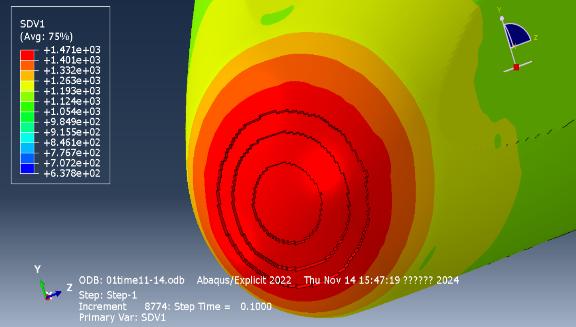Accurate Analysis of the Electrical Performance of Hypersonic Vehicle Radomes under Thermo-mechanical Effects
DOI:
https://doi.org/10.62677/IJETAA.2508135Keywords:
Hypersonic vehicle, Radome, Thermo-mechanical effects, Finite element method, Electrical performance modelingAbstract
Under extreme flight conditions, radomes applied to hypersonic vehicles must simultaneously endure intense aerodynamic heating and complex mechanical loads, leading to changes in material properties and structural configuration that significantly affect antenna electrical performance. This investigation presents an in-depth analysis of radome electrical performance under thermo-mechanical effects and proposes a precise integrated electrical performance analysis methodology for radome-antenna systems based on the finite element method. The approach establishes a coupled radome-antenna model through finite element analysis while considering material property variations induced by thermo-mechanical coupling. Based on temperature distribution characteristics obtained from finite element analysis, the radome undergoes layered processing where electrical parameter distributions are established layer by layer according to temperature-dependent material characteristics, providing a more realistic representation of radome electrical performance variations under high-temperature conditions. The proposed modeling methodology is validated through antenna radiation analysis under typical operating frequency bands, demonstrating excellent agreement with experimental observations and providing crucial insights for next-generation aerospace system design optimization.
Downloads
References
G. A. Crone, A. W. Rudge, and G. N. Taylor, “Design and performance of airborne radomes: a review,” IEE Proceedings F (Communications,Radar and Signal Processing), vol. 128, no. 7, pp. 451–464, 1981.
M. S. Heydari, J. Ghezavati, M. Abbasgholipour, et al., “Various types of ceramics used in radome: A review,” Scientia Iranica, vol. 24, no. 6,pp. 2746–2756, 2017.
F. Chen, Q. Shen, and L. Zhang, “Electromagnetic optimal design and preparation of broadband ceramic radome material with graded porous structure,” Progress In Electromagnetics Research, vol. 105, pp. 445–461, 2010.
Y. Dan and J. Yang, “Electromagnetic performance analysis of inhomogeneous radome walls considering temperature and ablation,” Aerospace, vol. 10, no. 3, p. 271, 2023.
W. Duan, J. Xie, M. Bi, et al., “Study on the electromagnetic performance of radome with laminar ablation for reentry applications,” IEEE Transactions on Antennas and Propagation, vol. 72, no. 2, pp. 1842–1853, 2024.
A. Nag, R. R. Rao, and P. K. Panda, “High temperature ceramic radomes (HTCR)—A review,” Ceramics International, vol. 47, no. 15, pp. 20793–20821, 2021.
J. Jin and J. Wang, Finite Element Method for Electromagnetic Fields. Xi’an, China: Xidian University Press, 1998, pp. 54–94.
Y. Chen, M. Wu, S. Zhang, et al., “Preparation and dielectric properties of low dielectric fused silica ceramics,” Electronic Components and Materials, vol. 29, no. 8, pp. 45–48, 2010.
R. U. Nair and R. M. Jha, “Electromagnetic performance analysis of a novel monolithic radome for airborne applications,” IEEE Transactions on Antennas and Propagation, vol. 57, no. 11, pp. 3664–3668, 2009.
P. S. Mohammed, C. V. Vinisha, S. Vandana, M. Suprava, and R. U. Nair,“Electromagnetic performance analysis of graded dielectric inhomogeneous streamlined airborne radome,” IEEE Transactions on Antennas and Propagation, vol. 65, no. 5, pp. 2718–2723, 201

Downloads
Published
Issue
Section
Categories
License
Copyright (c) 2025 Pengfei Zhao, Xinyuan Zhou, Xuefeng Cheng, Yi Ren, Shengpeng Zhang (Author)

This work is licensed under a Creative Commons Attribution-NonCommercial 4.0 International License.




